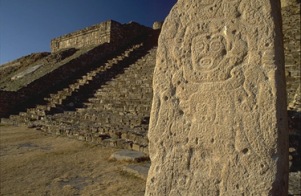| ||
|
Several thousand years ago, small nomadic bands wandered this region living a hunter/gatherer existance. These were the ancestors of the Zapotec indians.
With the discovery of basic farming techniques, these nomads began to settle in small communities, forming the roots of the Zapotec nation. As people and knowledge started to centralize, the Zapotecs also turned their efforts towards academic endeavors, creating their own writing system and religious and solar calendars.
Around 500 BC, the villages in the region banded together to create a central capital. A mountain top was chosen with a clear view of each of the surrounding three valleys. First taking on the gargantuan task of leveling off the top of the mountain, the Zapotecs built a ceremonial center which would eventually hold temples, an observatory, and a ball court. This was Monte Albán.
On the surrounding mountainsides, a vibrant community sprang to life. By 200 BC it had grown to 15,000, and by 450 AD it had reached a peak of 25,000, spreading across Monte Albán's terraced slopes.
This was the center of a Zapotec empire that would span much of today’s modern day Mexico.
Around 700 AD, for reasons not completely known, the people of Monte Albán began to drift away, settling in villages throughout the valley. Some theorize that once-dangerous external threats had ceased to exist. Others suggest that the city outgrew the agricultural ability of the surrounding land.
Whatever the reason, the loss of its central source of power lead to the end of the Zapotec empire’s supremacy. By 900 AD the Mixtecs had replaced them as the region’s power. Several hundred years later, it was the Aztecs who were consolidating power over the Zapotecs.
But the event that would have the most impact on the lives of the Zapotec indians was the arrival of the Spanish in the 1500’s.
As was their practice throughout their conquests, the Spanish set about converting the Zapotecs to Christianity soon after their arrival. The Zapotecs, rather than abandoning their own religion in favor of Christianity, simply combined them. Some elements of that combination exist even today.
The arrival of the Spanish was devastating to the Zapotecs. During the colonization period of the 1500’s and 1600’s, the population plummeted from 450,000 to 35,000, mostly due to diseases such as smallpox, the plague and measles. There were times when these diseases killed several people a day in Teotitlán alone.
From those who remained among the living, the Spanish required a tribute. The people of Teotitlán del Valle paid a tribute in cotton cloth. The Spanish also instituted a system of forced labor called "repartimiento," effectively making the indians slaves.
Today, the Zapotecs are one of Mexico’s largest indigenous groups with a population of around 500,000. They remain a separate group of people, with their own language and a distinct culture. Zapoteca remains the primary language spoken in the home.
While they share a common language, people from different villages often have a difficult time understanding one another, as the Zapotec dialect can differ substantially from village to village. It's not uncommon for people from different villages to use Spanish as a common language.
Today's Zapotecs retain much of their traditional culture, not least through crafts such as weaving and pottery. Many are among the poorest of Mexico's citizens.
The primary sources of income for the Zapotecs are farming and various crafts, such as weaving or pottery.
|
||
|
The Zapotecs | FAQ | Gallery | Site Map | The Store | About Artisans in Focus | E-mail
|

